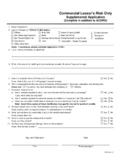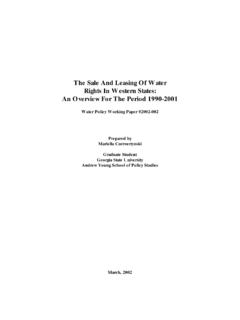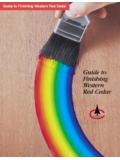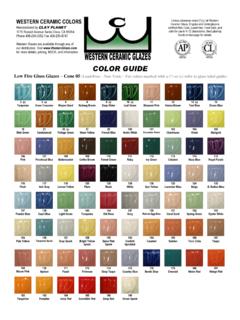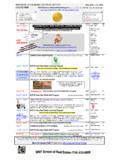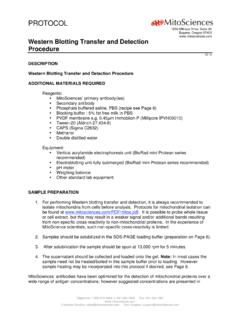Transcription of .22 Rim Fire Boxes
1 western Cartridge Company East Alton, Ill Created and Edited By Roger E. Huegel 2014 .22 Rim Fire Boxes of the ID. Reference western Cartridge Co. WCC THANKS Special thanks to the following collectors for helping me with this project by supplying me with box images and sharing their knowledge. Presented in alphabetical order. CONTRIBUTORS J B B C D C R E D G J H G H B H B M G M P M C S M R R .22 B N western Cartridge Co. WCC HEADSTAMPS (h/s) Headstamp drawings courtesy of the RIMFIRE HEADSTAMP GUIDE by George Kass and Ron Merchant 2-1 7-1 N-1 SU-1 W-3 western Cartridge Co. WCC-0 The Early History Franklin W. Olin, the founder of the western Cartridge Company was born in 1860. His father was a timber cuter in a Vermont lumber camp.
2 The younger Olin gained an engineering degree from Cornell University in 1886. After completion of his schooling, he worked in a patent attorney's office. Then he worked designing machines for the knitting industry_ One of his inventions was the process of adding more thread to the toe and heel of socks to reduce wear. He gained experience in the powder industry by designing and building several powder mills in the eastern states. F. W. Olin saw that the industrial needs of the United States in the post-civil war period was for black powder for use west of the Appalachian mountains. Black powder, or as it was called blasting powder, was the premier explosive of that day. The major user being the growing mining industry in the southern Illinois area. Moving to East Alton, Illinois, Olin worked with several other investors to create the Equitable Powder Company in 1892.
3 Production started in 1893. Growing blasting powder demand allowed the company to grow. Equitable established mills near Fort Smith, Arkansas and Herrin, Illinois. Their sporting gun powder was in demand because this was the western most company producing any type of powder for the western trade. To capitalize on the demand for sporting gun powder and loaded ammunition, Olin formed the western Cartridge company in 1898. At first, western only sold powder and loaded shotgun shells. They purchased most of their components from other manufacturers. The ammunition was loaded in machine which had been designed by Franklin Olin. As western 's sales grew the larger Eastern ammunition manufacturers attempted to squeeze out the new company by denying them the components required to load ammunition. To stay in business, Olin was forced to become a supplier of his own components.
4 He designed his own shotshel1 manufacturing equipment. He even created his own shot tower. His training as an engineer was beginning to payoff, plus his background in the knitting industry helped him understand accurate machines. His service working for a patent attorney probably helped him gain patent protection for his ideas. Franklin W. Olin The western Plant in 1910 western Cartridge Co. WCC-0 The Early History For primers and blasting caps, he looked to a partnership . with someone with chemical expertise. About 1902, Franklin Olin co-operated with the Austin Cartridge Company of Cleveland, Ohio to launch a small plant on the grounds of the western Cartridge Company to produce metallic cartridges and blasting caps. This was the first production of .22 rimfire ammunition by western . This new venture was named the Union Cap & Chemical Company.
5 In 1909, western purchased the assets of the Austin Cartridge Company and the Union Cap and Chemical Company's .22 Boxes started to show the western name. The western Cartridge Company purchased the National Cartridge Company in 1909. For a short period of time, they retained the format of the National Cartridge Company, but added the western name to the side of the Boxes . This placed the western Cartridge Company firmly in the business of selling .22 rimfires, both under their own name, but also being a supplier to Sears and Roebuck, one of the nation's largest retailers. Yet the did not have their own brand identification, as their .22 Boxes still carried the format of the Union Cap & Chemical Company or the National Cartridge Company. The western Cartridge Company was also growing in its ability to produce different types of powder. They were producing not only black powder, but smokeless and a semi-smokeless powder, which they called "Nublend".
6 The semi-smokeless powders were dropped about 1916 and replaced with the "Lesmok", which they purchased from DuPont. In 1910, western created a new format for their cartridge product line, including the .22 rimfires. This new format is referred to as the Diamond Logo issues in reference to the diamond shaped logo in the center of the label. About the same time, a new headstamp was introduced, a diamond. This headstamp is 2-1 in the Kass headstamp guide. The western Cartridge Company's .22 rimfire product line expanded at a rapid rate, along with their centerfire offerings. Hollow point bullets were added. Offerings of .22 Remington and Winchester automatics were produced. Different loadings of the .22 Winchester rimfire were part of the product line. Smokeless powder produced by western and "Lesmok" powder from DuPont were used in the loadings.
7 By 1913, western was a full line .22 rimfire producer. The diamond logo issues remained in the product line until they were replaced with the "Bullseye" issues first produced in 1927. New developments were coming rapidly, including a dry lubrication of the bullets, which western named "Lubaloy" and a non-corrosive priming compound. The western Cartridge Company had overcome many handicaps and was rapidly becoming one of the major manufacturers of all types of ammunition in the United States. While any corporate success is the result of the combined efforts of many people, it was the guiding genius of Franklin W. Olin who provided the .spark to ignite the process. Franklin W. Olin died in 1951 at the age of 91. At that time, his company had grown to employ more than 60,000 people, worldwide. His products range from powders and ammunition, to firearms, to drawn brass products and many more products needed to supply a country that was growing as fast as the western Cartridge Company, his flagship.
8 western Cartridge Co. WCC-1 1908 MALTESE CROSS Issues S-1 S-3 S-4 S-2 western Cartridge Co. WCC-1 1908 MALTESE CROSS Issues About 1902, Franklin Olin co-operated with the Auston Cartridge Company of Cleveland, Ohio to form the Union Cap & Chemical Company right on the grounds of the western Cartridge Company. This partnership was needed to supply the chemical expertise for the production of primers and blasting caps. At that time, the major ammunition manufacturers were attempting to squeeze western out of business by denying them components. A natural evolution of business resulting in the In the Cap & Chemical Company producing .22 rimfire ammunition. In 1908, Franklin Olin purchased the assets of the Auston Powder Company. From that time on, the Union Cap & Chemical Company's .22 rimfire Boxes retained the older Maltese Cross format, but the western Cartridge Company's name was added to the top of the box.
9 In 1910, western replaced this format with their own, then new, Diamond logo format. S-1 .22 SHORT (BLANK). Buff box with black printing. One-piece box without a tray. No product code. "7-1" h/s on a copper case. Various colored wads noted in each box. This box was probably produced even after the Diamond logo period started. S-2 .22 SHORT (HIGH VELOCITY). Red, green and black label with white and black printing. Buff, two-piece full cover box. Full wrap-around end label. No product code. "7-1" h/s on a copper case. Lead bullets. S-3 .22 SHORT (HIGH VELOCITY). Red, green and black label with white and black printing. Buff, two-piece full cover box. Full wrap-around end label. No product code. "7-1" h/s on a copper case. Lead bullets. S-4 .22 SHORT (HIGH VELOCITY). "SMOKELESS". Same as S-3, except the label is now green, red and yellow and the ends read "SMOKELESS".
10 western Cartridge Co. SIMULATED WCC-1 1908 MALTESE CROSS Issues LR-1 LR-2 L-1 L-2 western Cartridge Co. WCC-1 1908 MALTESE CROSS Issues L-1 .22 LONG. (HIGH VELOCITY). "SMOKELESS". One-piece box with red, green and yellow label with black Contents unknown LR-l .22 LONG RIFLE (HIGH VELOCITY). "SMOKELESS". Green, red and black box with black printing. Two-piece full cover box. "7-1" h/s on a copper case. Lead bullets. LR-2 .22 LONG RIFLE (HIGH VELOCITY). "SMOKELESS". Green, red, and yellow box with black printing. One-piece box with end flaps. "7-1" h/s on a copper case. lead bullets. L-2 .22 LONG. (HIGH VELOCITY). Red, green and black label with white and black printing. Two-piece full cover box. Full wrap-around end label. No product code. "7-1" h/s on a copper case. Lead bullets western Cartridge Co. WCC-2 1910 First DIAMOND LOGO Issues S-8 S-8A S-9 S-8B western Cartridge Co.


